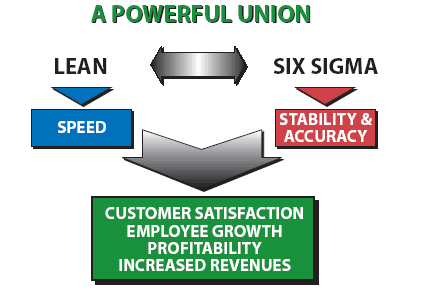
Six Sigma is a business management strategy, originally developed by Motorola that today enjoys wide-spread application in many sectors of industry.
Six Sigma seeks to identify and remove the causes of complaints and errors in service delivery and business processes. It uses a set of management methods, including statistical methods, and creates a dedicated infrastructure of people within the organization who are experts in these methods.
Six Sigma aims to deliver “Breakthrough Performance Improvement” from current levels in business and customer relevant operational and performance measures.
Business or operational measures are elements like:
- Customer Satisfaction Rating Score
- Time taken to respond to customer queries or complaints
- % Defect rate or complaints
- Cost of executing a business process transaction
- Yield (Productivity) of service operations or production
- Inventory turns (or) Days of Inventory carried
- Billing and Cash Collection lead time
- Equipment Efficiency (Downtime, time taken to fix etc.,)
- Accident / Incident rate
- Time taken to recruit personnel and so on…
Six Sigma initiatives are planned and implemented in organizations on “Project by Project” basis. Each project aims not only to improve a chosen performance metric but also sustain the improvement achieved.
Each Six Sigma project carried out within an organization follows a defined sequence of steps and has quantified financial targets (revenue increase, cost reduction or profit increase)
How is Six Sigma different?
Features that differentiate Six Sigma apart from previous quality
improvement initiatives include :
- A clear focus on achieving measurable and quantifiable financial returns from any Six Sigma project.
- An increased emphasis on strong and passionate management leadership and support.
- A special organization infrastructure of "Champions," "Master Black Belts," "Black Belts”, “Green Belts” etc. to lead and implement the Six Sigma approach.
- A clear commitment to making decisions on the basis of verifiable data, rather than assumptions and guesswork.
- The term "Six Sigma" is derived from a field of statistics known as process capability study. It refers to the ability of processes to produce a very high proportion of output within specification. Processes that operate with "Six sigma quality" over the short term are assumed to produce (long-term) defect levels below 3.4 defects per million opportunities (DPMO).Six Sigma's implicit goal is to improve all processes to that level of quality or better.
In recent years, Six Sigma has sometimes been combined with lean to yield a methodology named Lean Six Sigma.

Discover More on Lean Cleaning

LEAN Principles

LEAN Six Sigma Principles

Lean Six Sigma Cleaning



